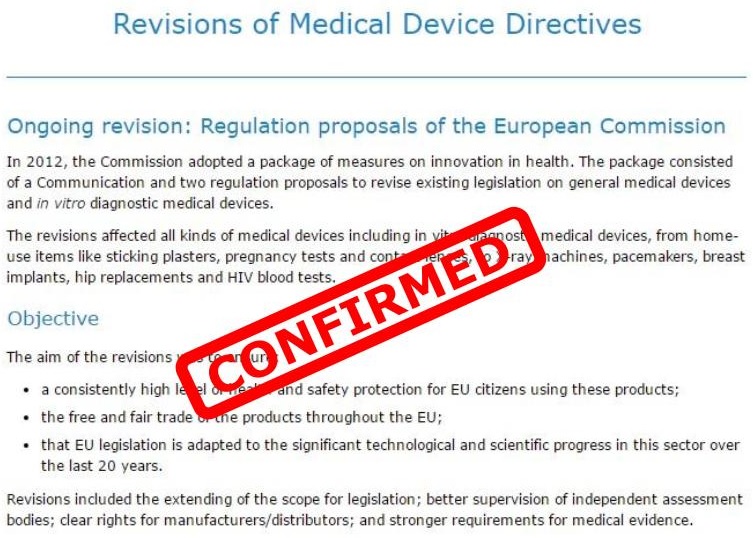MEDDEV 2.7/1 rev 4: How will your clinical evaluation change?
Article overviews of the new MEDDEV 2.7/1 rev 4 for clinical evaluation of medical devices, including a quality plan to comply with the latest revision.
What’s new in MEDDEV 2.7/1 rev 4 for clinical evaluations?
The third and fourth revisions both give manufacturers three choices: 1) a clinical literature review, 2) performing a clinical study, and 3) a combination of literature review and performing a clinical study. However, the fourth revision is completely re-written. The fourth edition is 19 pages longer, and it is now much harder to use the “literature only” route. The fourth revision includes stringent requirements for demonstrating equivalence between another device and your device. Therefore, many companies are now struggling to update their clinical evaluation reports to satisfy this new guidance document.
Overview of the content in MEDDEV 2.7/1 rev 4
The third and fourth revisions of the guidance both have a 5-stage process for clinical evaluations, but in the third revision, only articulated stages 1 through 3 as stages leading up to writing a clinical evaluation report. The figure in section 6.3 of revision four now identifies a planning Stage 0, and the writing of the clinical evaluation report is referred to as Stage 4. Therefore, there is a lot more detail describing the planning and report writing stages than there was in revision 3. In addition, Stage 2 (Appraisal of clinical data) has been expanded from a single page to eight pages.
Based upon the above changes, you can infer that Competent Authorities have been unsatisfied with the quality of clinical data being provided to support the essential requirements for safety and performance. In turn, Notified Bodies are expected to be much more critical of the data presented, and more guidance is provided to manufacturers. There is also much more guidance and more examples provided in the appendices, while the 12-page clinical evaluation checklist that was provided in revision three has been replaced by one page of bulleted items for Notified Bodies to consider.
Demonstration of equivalence
It is no longer sufficient to list several devices that are similar to your device and include those devices in your search of clinical literature. Now you may only select one device for equivalence. You must also provide a thorough analysis of equivalence with that device based on clinical, technical, and biological characteristics. This comparison includes providing drawings or pictures to compare the size, shape, and elements of contact with the body.
Updating clinical evaluations
The new European Medical Device Regulations (EMDR) is expected to specify minimum requirements regarding the frequency of updating clinical evaluations, but MEDDEV 2.7/1 rev 4 discusses this in section 6.2.3. The frequency of updating your clinical evaluations must be justified and documented. Many considerations for this justification are discussed, but the end of that section indicates that devices with significant risks (e.g., implants) require at least annual updates to the clinical evaluation report. For devices with non-significant risks, and where the device is well established (e.g., a long clinical history), 2-5 years is the range of possible frequency. Longer than five years are not allowed.
Who should perform clinical evaluations?
Many device manufacturers are receiving nonconformities because the evaluators are not sufficiently qualified, or the qualifications are not documented. The qualifications must follow 6.4 of the new guidance, and the qualifications set by your company should be documented in your procedure for clinical evaluations. You will need to document these qualifications with more than an abstract, but you will also need to present a declaration of interest for each evaluator. Evaluators need knowledge in clinical study design, biostatistics, information management, regulatory requirements, and medical writing. Evaluators also need knowledge specific to the device, its technology, and its application. Evaluators must also have a higher education degree in the field and five years of experience or ten years of experience if they do not have a higher education degree. Due to the breadth and depth required of qualifications required, it may be necessary to assemble a team to perform evaluations.
Creating a quality plan for compliance with MEDDEV 2.7/1 rev 4
Seven steps need to be included in your quality plan for compliance with MEDDEV 2.7/1 rev 4:
- update your external standards to replace MEDDEV 2.7/1 rev 3 with MEDDEV 2.7/1 rev 4
- revise your procedure and associated templates for a literature review and clinical evaluation report to meet the requirements of MEDDEV 2.7/1 rev 4
- document the qualifications of evaluators for clinical evaluations
- document a plan/schedule for updating your clinical evaluation reports for each product family
- train evaluators, regulatory personnel and any applicable internal auditors on the requirements of MEDDEV 2.7/1 rev four and updated procedures and forms
- begin updating clinical evaluations according to your plan
- perform an internal audit of your clinical evaluation process
Learning more about MEDDEV 2.7/1 rev 4
If you are interested in learning more about this revised guidance document, please register for our live webinar on Friday, January 27 @ Noon EST by clicking on the button below.
MEDDEV 2.7/1 rev 4: How will your clinical evaluation change? Read More »














